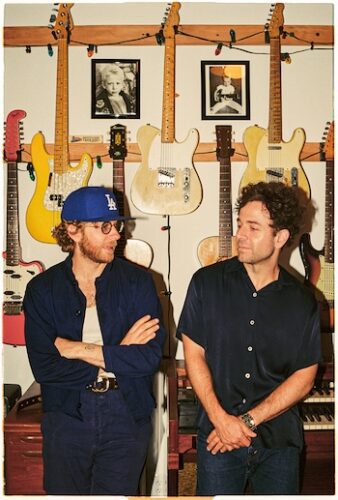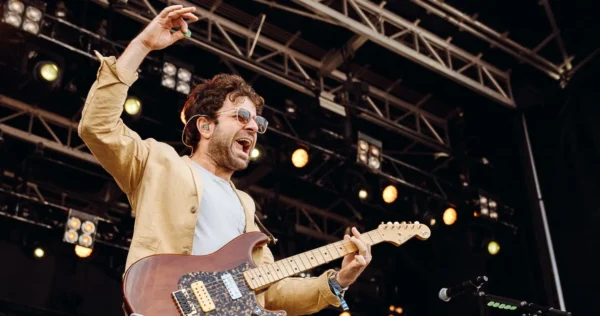Musician Interview: Taylor Goldsmith of Dawes on the Making of “Oh Brother”
By Robert Duguay
“Every record makes the setlist better because we get to keep the things that have really been killin’ and then do things that make you push yourself because these are songs that you haven’t played in several years.”
The careers of many bands go through transformations, sometimes planned and sometimes not. This could mean a change of vision or producers, perhaps moving to different studios or locations. At its most radical, it can mean a shake-up in the group’s lineup. The Los Angeles folk-rock act Dawes, co-founded by brothers Taylor and Griffin Goldsmith, found itself grappling with the latter after the amicable departures of bassist Wylie Gelber and pianist and keyboardist Lee Pardini last year. The Goldsmith duo recorded its ninth full-length album, Oh Brother, after the exodus. It was released on October 11 via the band’s own label, Dead Ringers. As part of its tour in support of the disc’s release, Dawes will be performing at Roadrunner in Boston’s Allston neighborhood on November 22. Fellow Angelinos Winnetka Bowling League will start the night off at 7 p.m.
Taylor and I had a talk ahead of the show about what it was like for the brothers to make the album, what creating a music video with Conan O’Brien was like, and memories of previous Dawes shows in Boston.

(L to R) Griffin and Taylor Goldsmith of Dawes. Photo: Jon Chu
The Arts Fuse: The liner notes claim that Oh Brother was made in a room the size of a bathroom over the course of a couple weeks. Really?
Taylor Goldsmith: The studio is called Bare Bones. It’s a shed that our producer Mike Viola had built next to his house. It’s next to his garage, basically, and he somehow found a way to get amazing sounds. It required a lot of commitment and it required us to be intentional with the sounds we were getting, but it was thrilling because we were so close together. It forced us to abandon all of these studio aesthetic rules about needing a certain amount of space for drums. We were just doing whatever we could to make it sound good, and once it sounded good, we just kept rollin’. There were so many songs where I would be playing acoustic guitar and singing the lead vocal right next to Griffin, who was playing the main drum track.
We knew beforehand that we had to commit to these sounds and commit to these takes. It helped move things fast. It contributed a lot to the way that the record sounds, which I’m really proud of. Some records that are hi-fi are a little bit boring and antiseptic, and there’s lo-fi records that are a little bit off-putting because there wasn’t enough TLC put into it. We have come up with a fun combination of sounds that are different and interesting. But there’s no studio magic, with extensive gear and crazy mic sounds. I wouldn’t say that it’s scrappy and lo-fi because what Mike gets is really special. Let’s say we made do with the environment we were in.
AF: Where was the photo for the album cover taken with you and your brother Griffin surrounded by various framed photos, figurines, pennants, and tapestries? Was this in Mike’s studio or somewhere else?
Goldsmith: That’s actually in our studio, which is in the back of my house. We were building that while we were recording and I’m a little less adept with studio stuff than my brother is, so the whole time I was thinking that we would do half of the album at Mike’s house and then we’d do half of it at our studio once it’s done. My brother was like,”I don’t think you realize how long this shit takes.” He was right. Our studio took longer and longer to take shape, to get everything wired, installed, and read. Mike’s was sounding good so we didn’t want to lose any momentum — so we finished up at Mike’s. That wall was built at the new studio, even though nothing has yet to be recorded there.
AF: How were you able to get Conan O’Brien involved in the music video for the track “Mister Los Angeles”? What was the experience of making it with him, where he took on the role of a casting agent?
Goldsmith: We played in Newport this year with him as his band at the Newport Folk Festival. That was put together by our mutual friend Jim Pitt, who used to book Conan’s show. He’s a big supporter of Dawes and now he books Jimmy Kimmel Live. Conan was approached to do Newport and, because we have a deep relationship with the Newport Folk Festival, it made the sense to make Dawes his band. We had a great time.

Taylor Goldsmith of Dawes. Photo: Brent Goldman
Then a few weeks later, when we were putting together content for the album, we were trying to figure out how to promote it.We had an idea for “Mister Los Angeles” and it involved someone like him. So I hit him up: “You’re way out of our league and I understand that, but I’m just throwing this out there in case you want to do it. If you’re too busy, just don’t even worry about it and I would totally understand.” He responded back right away and he was like “I’m in, count me in. I’d love to, I want to help if I can” and he just got in on the ground floor with us, emailing with the director right away about what he thought would be most effective creatively. He just really gave a shit in a way that he didn’t have to.
He could have just shown up and said, “What do you need? I’ll be here until noon,” but instead he was like “Let’s get this right.” He was so kind, generous, and funny; he made everybody laugh. He was very invested and that’s reflected in the final product.
AF: You grew up in Southern California. Given that background, what are your thoughts on coming to the other side of the country to play in Boston?
 Goldsmith: We’ve done some of our biggest and best shows in Boston. The fan base for us there has always been really strong. When we had our first Beacon Theatre show we sold it out in New York and it felt so exciting. Then the very next night we played The Orpheum in Boston. The capacity there was even bigger and that show sold out. It was a really special moment; Boston was leading the charge for us. I also associate the city with the Newport Folk community. We have pretty much the same connection with them that we have with our Boston fan base. Seeing both of them is like visiting old friends.
Goldsmith: We’ve done some of our biggest and best shows in Boston. The fan base for us there has always been really strong. When we had our first Beacon Theatre show we sold it out in New York and it felt so exciting. Then the very next night we played The Orpheum in Boston. The capacity there was even bigger and that show sold out. It was a really special moment; Boston was leading the charge for us. I also associate the city with the Newport Folk community. We have pretty much the same connection with them that we have with our Boston fan base. Seeing both of them is like visiting old friends.
AF. How do you craft your set list, balancing playing songs from the new release with the older material? Do you discover relationships between songs that you didn’t know existed?
Goldsmith: Every record makes the set list better because we get to keep the things that have really been killin’ and then do things that make you push yourself because these are songs that you haven’t played in several years. That’s always been a fun part of being a touring musician. I feel that other artists, whether they’re filmmakers or painters or novelists, it’s not like you often get to link up with your fans and perform a rundown of everything you’ve done up to that point. But with music that’s very much what you do. It’s sort of like opening up your toy chest and spending another five minutes with something you played with back in 2009.
For live shows we dive into the whole catalog. We try to keep the set list changing because we want to keep ourselves on our toes. For the fans who are connected to the band in a deep way — and typically these are ones who go to the concerts — we try to make sure the show is special, an occasion when they can catch a song that we haven’t played yet or a song that people have been asking for.
Rob Duguay is an arts & entertainment journalist based in Providence, who is originally from Shelton, CT. Outside of the Arts Fuse, he has also written for DigBoston, Aquarian Weekly, Providence Journal, Newport Daily News, Worcester Magazine, New Noise Magazine, Manchester Ink Link, and numerous other publications. While covering mostly music, he has also written about film, TV, comedy, theater, visual art, food, drink, sports, and cannabis.
